
231/1 BIOLOGY
Paper 1
Answer all the questions in the spaces provided.
1. (a) What is meant by the term binomial nomenclature? (1 mark)
………………………………
(b) State two guidelines that should be followed when typing scientific names.(2 marks)
…………………………….
2. During a lesson, students observed the structure of bat, cat and human forelimbs to determine their evolutionary relationship.
(a) State the name given to the structure of the limbs observed by the students(1 mark)
……………………………
(b) Name the type of evolution illustrated by the structure of the limbs observed.(1 mark)
…………………………………
(c) What evidence of evolution is illustrated by the limbs? (1 mark)
……………………………..
(d) State the significance of the type of evolution illustrated by the limbs. (l mark)
……………………………..
3. An individual is of blood group B positive.
(a) Name the antigens in the individuals blood. (2 marks)
………………………………
(b) Give the reason why the individual cannot receive blood from a blood group A donor.(2 marks)
…………………………..
4. Colour blindness is a sex linked trait controlled by a recessive gene b. If a mother is a carrier and the father is normal, What is the chance that their son will be colour blind? Show your working. (4 marks)
………………….
5. (a) State two advantages of using a coverslip when preparing a specimen for observation under a light microscope. (2 marks)
…………………….
(b) How is the low power objective lens manipulated to focus a specimen for observation under a light microscope? (2 marks)
…………………………..
6. Students set up an experiment as illustrated below.

(a) Name the physiological process that resulted in the observations made after 30 minutes.(1 mark)
……………………………
(b) State the importance of the physiological process investigated in plants. (1 mark)
…………………
(c) Explain the observations made after 30 minutes. (2 marks)
…………………………
7. How is a guard cell structurally adapted for gaseous exchange? (4 marks)
……………………
8. (a) Name the organism that: –
(i) causes malaria; (1 mark)
…………………….
(ii) transmits malaria. (1 mark)
……………………….
(b) State two control measures for malaria. (2 marks)
………………………
9. The diagram below shows an experimental set up to investigate a certain physiological process in plants.

(a) State the aim of the experiment. (1 mark)
………………………
(b) State the role of the following in the experiment:
(i) potassium hydroxide; (1 mark)
……………………….
(ii)Aluminium foil.(1 mark)
……………………..
(c) Account for the expected colour change in tube F.(2 marks)
……………………..
10. The diagram below illustrates skulls of human adult and chimpazee.
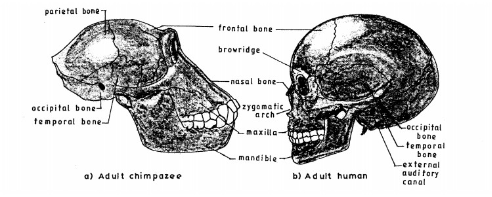
(a) State one difference the two skulls in the following structures:(3 marks)
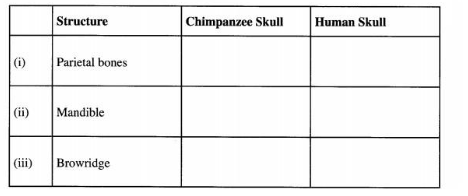
(b) State the significance of the evolution observed on the parietal bone in the chimpanzee and human skulls. (1 mark)
…………………………
11. Name two structures used for gaseous exchange in plants. (2 marks)
……………………
12. (a) What is meant by each of the following:
(i) pyramid of biomass? ( l mark)
………………….
(ii) pyramid of numbers? (1 mark)
…………………….
(b) During an ecological visit to the Savanna Grassland, students were able to see lions, antelopes, vultures and pastoralists grazing their cattle. Construct a food chain with four consumer levels to illustrate the energy flow in the ecosystem. (2 marks)
……………………….
13. State three differences between the end products of mitosis and meiosis.(3 marks)
………………………………………………..
14. (a) Name two types of involuntary muscles in mammals. (2 marks)
………………………
(b) State the location of each of the muscles named in (a) above. (2 marks)
………………………………….
15. The photomicrographs below show the various stages of cell division in a certain plant.
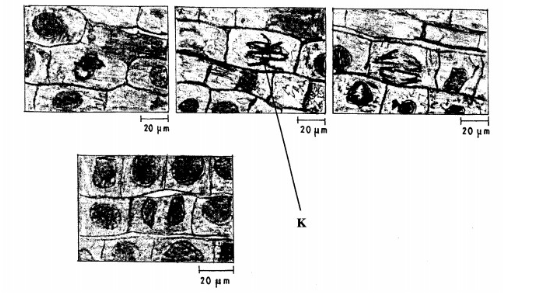
(a) (i) Name the type of cell division illustrated. (1 mark)
…………………………………
(ii) Give a reason for your answer in (a) (i) above. (1 mark)
………………………………….
(b) (i) Name the stage of cell division labelled K. (1 mark)
……………………….
(ii) Give a reason for your answer in (b) (i) above. (1 mark)
…………………………..
16. State four structural differences between millipedes and centipedes. (4 marks)
………………………………………
17. (a) How is a human stomach adapted to
(i) protein digestion? (2 marks)
………………………..
(ii) churning? (2 marks)
………………………..
(b) What happens to the glucose synthesized during photosynthesis? (2 marks)
………………………
18. The diagram below shows an experimental set-up to investigate the conditions necessary for germination. Test tube P was placed in a refrigerator while Q was left at room temperature. The set-ups were observed regularly for two weeks but no germination occurred.
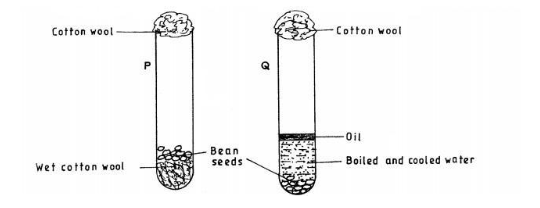
Explain the observations in P and Q.
P (2 marks)
…………………………..
Q (3 marks)
……………………………
19. (a) Using the axes provided below, sketch a curve to illustrate the growth pattern observed in the phylum arthropoda. (2 marks)
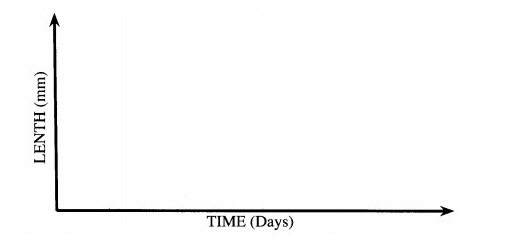
(b) Explain the growth pattern observed observed in arthropods. (3 marks)
………………………………….
20. Below are components of a simple reflex pathway:
- interneurone;
- muscle;
- motor neurone;
- sensory neurone;
- pain receptor;
- central nervous system.List the components in their proper sequence during the transmission of a nerve impulse.(3 marks)